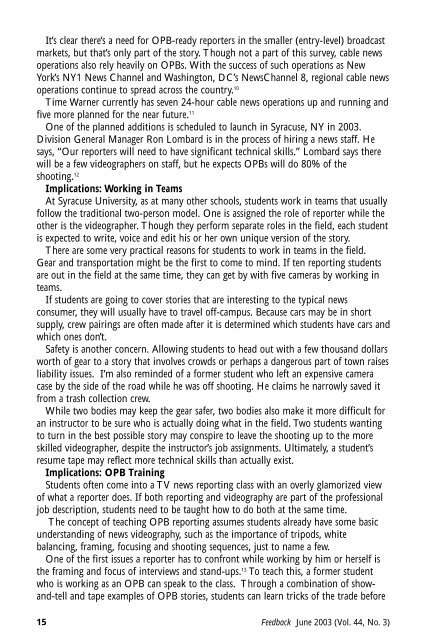JUNEFeedback
Issue 3 - Broadcast Education Association
Issue 3 - Broadcast Education Association
You also want an ePaper? Increase the reach of your titles
YUMPU automatically turns print PDFs into web optimized ePapers that Google loves.
It’s clear there’s a need for OPB-ready reporters in the smaller (entry-level) broadcastmarkets, but that’s only part of the story. Though not a part of this survey, cable newsoperations also rely heavily on OPBs. With the success of such operations as NewYork’s NY1 News Channel and Washington, DC’s NewsChannel 8, regional cable newsoperations continue to spread across the country. 10Time Warner currently has seven 24-hour cable news operations up and running andfive more planned for the near future. 11One of the planned additions is scheduled to launch in Syracuse, NY in 2003.Division General Manager Ron Lombard is in the process of hiring a news staff. Hesays, “Our reporters will need to have significant technical skills.” Lombard says therewill be a few videographers on staff, but he expects OPBs will do 80% of theshooting. 12Implications: Working in TeamsAt Syracuse University, as at many other schools, students work in teams that usuallyfollow the traditional two-person model. One is assigned the role of reporter while theother is the videographer. Though they perform separate roles in the field, each studentis expected to write, voice and edit his or her own unique version of the story.There are some very practical reasons for students to work in teams in the field.Gear and transportation might be the first to come to mind. If ten reporting studentsare out in the field at the same time, they can get by with five cameras by working inteams.If students are going to cover stories that are interesting to the typical newsconsumer, they will usually have to travel off-campus. Because cars may be in shortsupply, crew pairings are often made after it is determined which students have cars andwhich ones don’t.Safety is another concern. Allowing students to head out with a few thousand dollarsworth of gear to a story that involves crowds or perhaps a dangerous part of town raisesliability issues. I’m also reminded of a former student who left an expensive cameracase by the side of the road while he was off shooting. He claims he narrowly saved itfrom a trash collection crew.While two bodies may keep the gear safer, two bodies also make it more difficult foran instructor to be sure who is actually doing what in the field. Two students wantingto turn in the best possible story may conspire to leave the shooting up to the moreskilled videographer, despite the instructor’s job assignments. Ultimately, a student’sresume tape may reflect more technical skills than actually exist.Implications: OPB TrainingStudents often come into a TV news reporting class with an overly glamorized viewof what a reporter does. If both reporting and videography are part of the professionaljob description, students need to be taught how to do both at the same time.The concept of teaching OPB reporting assumes students already have some basicunderstanding of news videography, such as the importance of tripods, whitebalancing, framing, focusing and shooting sequences, just to name a few.One of the first issues a reporter has to confront while working by him or herself isthe framing and focus of interviews and stand-ups. 13 To teach this, a former studentwho is working as an OPB can speak to the class. Through a combination of showand-telland tape examples of OPB stories, students can learn tricks of the trade before15Feedback June 2003 (Vol. 44, No. 3)
















